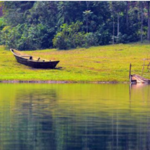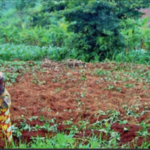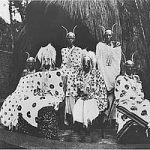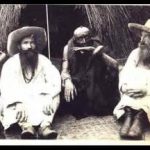The White Fathers’ Mission in Rwanda II
An Overview II
It seems likely that lineages from the Singa, Sindi, Zigaba, Gesera, Banda, Cyaba and Ungura clans, through a combination of land ownership and ritual expertise, managed to impose themselves on settlers from diverse clans to form small priest-led kingdoms. The kingdoms that survived into the twentieth century relied on the belief in the religious powers of the Hutu, priest-king, called umwami in the south-west and umuhinza elsewhere. Such kingdoms were certainly- privileged remnants, isolated by forest and unsuitable for cattle-grazing, of a more extensive and ancient type of organization.
The umuhinza of Busozo in south-west Rwanda lived in complete seclusion until a male heir reached seven years of age. He wore only barkcloth and always conferred with his elders; from behind a partition. All food given him had to be carefully washed, covered by banana leaves, and only tasted by pre-pubertal children. No person with sores or deformities was allowed to approach the royal enclosure and the king himself was not permitted to cross a nearby river. He ruled in conjunction with Queen-Mother herself constantly attended by two applauding women; all visitors left her presence bent double with hands touching the ground. A future umuhinza was believed to be born clasping a calabash of’ milk in one hand and seeds in the other; after the age of seven he had to be secluded in the royal enclosure.
An umuhinza like heads, of` imiryango could grant land cleared from the forest in exchange for a siekle. People who alienated land, in exchange for two or three hoes or a goat per hectare, paid one hoe to the umuhinza. Delimitation of cleared land required the presence of the local Twa chief who received a goat for the right to ‘open up the forest’, urwagururo. All land-owners sent the first fruits of the harvest to the umuhinza for the first-fruit ceremonies. Thus although the prior rights of the forest hunting Twa were acknowledged, once the land was planted it fell under the jurisdiction of the umuhinza. Land was not reified property, rather different groups claimed spiritual jurisdiction over different aspects of its creative potential. The spiritual authority of the umuhinza hinged on the belief that he could control rainfall and crop pests; he was mwami w’imvura. Ndaganot the priest-king of’ Bukunzi, for example, was said to sometimes live in the clouds.
The divinised persons of the Hutu kings performed a similar functional role to that of eponymous ancestors, they were symbols of unity and watched over the part of life that fell outside the narrow confines of the inzu. The land of the inzu was linked to lineage spirits; while the umuhinza presided over the destiny of the whole kingdom.
The aseity and structural position of the Hutu king made it conceptually necessary to believe that his spirit passed through a number of transformations, it did not immediately become an umuzimu at death. The body was smoked and dried and the spirit thought to pass first into a worm and than into a leopard.
“The Tutsi mwami was believed to undergo comparable transformations. For similar beliefs amongst the neighbouring Havu, see Verdonck Rev. Père ‘Décès du Mwami Rushombo; Intronisation du Mwami Bahole’ Congo, 1928, 294 – 308 “
Oral tradition indicates that during- the rein of the Rwandan mwami Kigeri I Mukobanya in the early sixteenth century Nduga was such a kingdom led by a Banda clan territorial cult medium. Formation of politico-religious units above the clan level may have been accelerated by interaction between Hutu and newly- arrived Tutsi clans, cultural and economic interchange, or defence needs throwing up new leaders. Whatever, there is no reason to posit the ‘diffusion’ of divine kingship along: lines of Tutsi immigration from a source outside Rwanda.
The dating of the Tutsi’s arrival is largely conjecture; the thirteenth century from south-west Ethiopia as a dispersal point has been suggested, and their language may have been Cushitic. More convincing is de Heusch’s study of the Cwezi cycle of myths which suggests an immigration route through Karagwe and Uzinza via Gisaka. The cattle-herding Tutsi would have settled along the valleys of south-east Rwanda where they perhaps traded milk, skins and meat for local grains. Clans which today have over 30% Tutsi membership and so may be assumed to have formed part of the original migrations are the Kono, Ha, Shinga, Nyakarama, Sita, Shambo, Tsobe, Nyiginya and Ongera. However, the multiclass character of Rwandan clans makes such projections tentative.
Vansina has identified Ndahiro Ruyange in the Rwandan king-list as the first non-mythical figure of the Nyiginya dynasty. Thus, probably for reasons of defence, Tutsi lineages around Lake Muhazi in Buganza had developed a major chieftancy by the turn of the fifteenth century. The king was doubtless little more than primus inter pares of a number of cattle-rich and nomadic-chiefs. The cohesion of the nascent Rwandan State was probably no greater than that of the Hutu kingdomS with their ritually powerful abahinza, a congeries of warlords gathered together for raid and to protect their herds.
The rise of Rwandan kingship and the expansion of the Rwandan State cannot be dated accurately though some of the processes may be tentatively reconstructed. The assimilation of neighbouring kingdoms would have involved a number of related events: colonisation by pastoralists, formation of secondary vassal kingdoms, and the incorporation of religious specialists into the entourage of the Rwandan mwami. Cattle, used to recruit followers and reward military service, was probably the basis of the king’s power; his weakness lay in only tenuous claims to rights over land and hence ritual authority. The Hutu leaders incorporated as ritual specialists; around the mwami would have partially, filled both these deficiencies.
Vansina does sussent that Tsobe lineages were incorporated as abiru at court as a result of mwami Mukobanya’s conquests in the sixteenth century. Such officials could have bolstered the Tutsi monarchy with rituals and ideology drawn, at least in part, from pre-existing Hutu kingship.
The Gesera, Zigaba and Singa clans, abasangwabutaka, ‘those who were found on the land’ were still required in the colonial period to legitimate Tutsi settlement and the installation of huts on‘ new land. When royal residences were being built., officials of the Zigaba clan acte as intermediaries with Hutu spirits and interceded for the mwami.The Zigaba are therefore known as thee abase of the leading Tutsi clans, Nyiginya and Ega, the Singa are in the same relationship with the Sita., The presence of the wagtail, inyamanza, the Gesera totem, was also said to be necessary before any Tutsi would contemplate settling on a hill.
There seems to have been a range of response to the politico-religious forces; encountered in subjugated neighbouring kingdoms. While the Tsobe became the important figures at court, dangerous ritualists like Mashira of Nduga were simply; executed and their country invaded. Privileged Hutu kingdoms had the impression of retaining their autonomy, or were truly independent, while the Rwandan mwami manipulated theeir prestige and power. By a combination of matrimonial alliances, blood pacts and open conquest, the Rwandan kingdom expanded northwards.
The invasion of Nduga was the result of raids from warlike clans from the Bunyoro region of Uganda; the young State had been in retreat and seriously defeated. Vansina has suggested that these defeats were a spur to the development of what was to be the key to Rwandan expansion, its well organised army.Each regiment, ingabo,was put under an army chief, umutware, who gathered around him an elite core of troops known as intore. Whole lineages were recruited en bloc for major raids and the royal intore were well trained, highly competent soldiers and athletes.
The willingness of lineage heads to join an ingabo may have been dictated by the need for protection and support in interfamilial and interclan disputes. There was no effective way of enforcing verdicts given by an umuhinza in Hutu kingdoms, and disruptive vendettas were common in the north: The social significance of the ingabo was that it provided scattered lineages with a new corporate identity and source of strength, the regiment. Each ingabo had its title and recruited from a wide area; its exploits were built into a body of traditions familiar to its members. An umutware could add to his stock of cattle by raiding, and distribution of booty, plue judgement of disputes between lineages and kinsmen, allowed him to become a territorial chief as much as a representative of the mwami. On coming to power a new mwami formed his own ingabo, and could reduce the power of rival regiments by summoning their elite troops.
The proliferation of ingabo and the successful raiding of the sixteenth and seventeenth centuries may have provided conditions conducive to the growth of cults above the level of lineage and clan religion. In this sense, the spread of the cult of Lyangombe and the success or Mithraism in the lower ranks of’ the Roman army were perhaps comparable developments. The mandwa spirits of the Lyangombe cult are of a higher order than lineage spirits against whose malevolent designs they are said to provide protection. They related the initiate to a spiritual world more extensive than that or the inzu and hill settlement just as the ingabo united the peasant to lineages scattered throughout the Rwandan State. A sacrificial warrior heroe, Lyangombe headed the spirit order.
It is possible that under the influence of ingabo service protective ceremonies formerly associated with clan heads became more popular, incorporated warrior heroes, and came to encompass non-clan members. From traditions that link Lyangombe to a conflict with, the usurper mwami Ruganzu Ndori the cult hero may be identified as an umuhinza from the marches of either Ndorwa or Burundi whose defeat an death in a Rwandan conquest in disguised) in the cult mythology. The Nduga’s umuhinza, Mashira, does turn up as an imandwa spirit in the cult. The model of a progressive assimilation of foreign religious sources of power is consistent with the idea that the Rwandan State should tolerate a cult dissipating popular discontent in a theatrical cathartic liturg addressed to deceased heroes.
Cult membership is controlled by diviners who diagnose the need for imandwa protection. In his first initiation, the neophte undergoes the usual humiliations of transition rites; he is dragged along naked, accused of being a rebel, umugome, and covered in cow dung. The neophyte then has the right to attend cult sacrifices without fear of beins chased away by the representative of Binego, the second major spirit. He has entered a new family and may later take a second grade to become one of the thirty or so spirit medium who represents the imandwa spirits. Lyangombe possession confers on the medium the right to be treated and referred to as Umwami.
Initiation guaranteed protection from dangerous lineage spirits and eternal bliss; with the imandwa in an afterlife on Muhabura volcano. The lobelia growing round the crater of this volcano, in the north-west of modern Rwanda, were said to be tobacco plantations; guarded by Lyangombe’s sacred sheep and cow. The future paradise was a mundane utopia with a liberal supply o beer, meat and tobacco. The uninitiated were condemned to perdition inside the crater of a second; active, volcano called. Nyiragongo, where they would be imprisoned by Lyangombe’s warriors. The salvific theme recurred in traditions which presented Lyangombe as a sacrificial saviour, a stereotype also to be fund associated with some Nyiginya abami, the Abatabazi, kings who died to save their people. Since these volcanoes remained outside the Rwandan State until the nineteenth century, and were distant from the ‘nuclear’ kingdom, the imandwa may only have been moulded into a “culte de salut” during the traumatic upheavals of’ Rwabugir’s reign, just before the Europeans arrival.
According to Kagame, initiation for everyone was first prescribed by court diviners during an epidemic in the mid- seventeenth century. This may be an explanation for the first major movement of noble lineages into the cult. Vansina dates the first arrival of imandwa mediums at court a century later. From this time onwards there was a permenent group of court mediums, the impara headed by delegate of the king, the mwami w imandwa. The mwami himselr remained ineligible for initiation. Cult organisation was not centralized however; the impara exerted no more control over mediums on the hills than was exercised by the royal diviners over local abapfumu.
The ritual purity of the realm came to be the responsibility of’ the mwami w’ imandwa who was said to send impara to escort albinoes, underdeveloped girls, and the deformed out of the kingdom to perish in the Ndorwa swamps. Impara were oonvoked for periods of two to three months court service when they guarded the mwami’s residence in groups of six to ten. The king used them as a spiritual shield just as a peasant would seek imandwa protection from troublesome lineage spirits, it is significant that impara were formed at court at the same time as royal votive huts to deceased members of the royal lineage were built.
The question whether the cult was functionally integrative or a contestation of the established order, is only meaningful given two major premises: that the cult underwent no historical development and that the Hutu-Tutsi division was manifest at this time. Neither seems likely. The ritual transformation of defeated kings to glory as saving spirits did not directly threaten the Rwandan State. On the other hand, no Rwandan abami featured in the cult.
« La geste des Imandwa se déroule », as de Lacger wrote ‘en marge des annales glorieuses de la patrie’
Vidal’s; portrayal of the spirit-representation and initiation rites as a type of morality plat re-inforcing the values of kingship seems plausible; but may it simply be assumed that the religious actors experienced this re-inforced commitment to the Rwandan order? The cult was not integrative in the colonial period if by this is meant that the Tutsi and Hutu came together in some liminal fraternity. Some Tutsi lineages frowned on the cult; no noble passed throughl the humiliations attendant on the initiation of a lowly peasant. One Tutsi might be found in a group of twenty mediums and vice-versa; a rich Hutu might get into a Tutsi group. This was hardly ‘integrative’. The Lyangombe cult speaks more of the religious needs of lineages swept up into the world of ingabo and warfare, and more of the assimilative capacity of the court, than of the ritual resolution of an anachronistic Hutu-Mutsi conflict.
As the LyangOmbe cult reached the court; Rwandan kingship was re-inforced by the accretion of religious mystique; the mwami was held to be endowed with Imana, the creative power of the spirit-world, and therefore to have supernatural powers. A royal ideology developed which emphasised the eternal and cyclical nature of the Rwandan kings; abami followed each other in a cycle of four rulers: Kigeri following a Mutera or Cyilima, Mibambwe after Kigeri and a Yuhi after Mibambwel the reign of each exemplifying a particular value like conquest or peace. The number of abiru was increased, perhaps to reduce the power of individual Tsobe lineages which controlled the succession, and a Queen Mother was chosen from four lineages in order to avoid fratricidal strife. As more lineages came to have access to power at court so the mwami became divinised and detached.
A major expansion of the Rwandan State began at the end of the eighteenth century. Mwami Cyilima Rujigira pushed out the frontiers into Bugoyi and the north, Ndorwa was subdued and a royal residence built there. As the independent state of Gisaka and Bugesera were defeated large numbers of men and rich tracts of land were brought under at least nominal Rwandan jurisdiction. But in most regions this expansion was not followed up by effective colonisation. In the small Hutu kingdoms;
and clan lands of the north, considerable resistance was met, collection of ikoro, tribute in crops and commodities; was erratic and depended largely on the degree to which it was in the interest of lineage heads to gain the Mwami’s support in local feuds. When Yuhi Gahindiro put an ennobled Twa over the province of Buhoma, its umuhinza led a major revolt. Bushiru was never effectively colonised until Belgian times.
As frontier posts controlled by permanent abatware were set up in response to raids from Burundi, Ndorwa and Gisaka, the number of land-owning nobles increased. These nobles were sufficiently powerful for the mwami Yuhi Gahindiro to delegate a new type of chieftancy with rights over pasture land, the abanyamukenke. The king also increased his own land-holdings and clients by granting ibikingi, one to several hills, as pastoral fiefs to his agents, often not men drawn from noble lineages. By such land grants throughout the kingdom, cutting into the nobles’ postures, and by the extensive use of Twa spies, the Rwandan king was able to keep the pretensions of powerful landowners under control. At the same time, he again increased the number of abiru to stop any one lineage gaining a monopoly of the esoteric code. The mwami was surrounded by abashobya who performed sacrifices and abahennyi who cursed his enemies, together with a host of minor officials and retainers.
The increased size of the Rwandan court did not alter its essentially nomadic character. The abami circulated round the royal residences placing a wife and retainers in each; the land was controlled by permanent province chiefs, abanyabutaka, often kinsmen, who provisioned the residences from the peasants’ fields. By usurping the position of local lineage heads through sheer force, or by interfering in land disputes and litigation, the chiefs came to control more and more land and to exact cropd dues and labour from the clients this afforded them.
Bananas, that were possibly introduced on a large-scale in the wake of invasions from Uganda, increased the value of already scarce land.
The expansion of Rwandan State control in the course of the nineteenth century meant for the Hutu peasants increasing oppression and insecurity. Individuals began to seek the protection of powerful nobles in whose patronage they might avoid the onerous uburetwa forced labour that the Tutsi chiefs began to impose. Such commendation was usually not, it seems, the result of a considered alliance between peasant and pastoralist, rather the product of a power struggle between a nuclear feudal cluster gathered round a noble and a local Hutu lineage -in which the latter was worsted.The client was often obliged to pay court for a considerable time before the patron accepted him in ubuhake. Commendation took the form of the Hutu presenting, the shebuja with a symbolic sheaf of grass; in exchange he was given usufruct rights over a cow. The bonded man umugarau, was obliged to render his lord customary service, the most important duty being the repair of hisenclosure; if a garagu failed to perform this duty annually all ubuhake cattle were forfeit and the relationship terminated.
The spread of ubuhake weakened the Hutu since individuals increasingly sought protection with the rich rather than in the solidarity of their lineage. Despite the defiant taunt that to be without a lineage was to be
‘like a dog’ the umuryango began to break down as some members communally fulfilled obligations to abatware and abanyabutaka while others sought individuel immunity in the patronage of a powerful noble. Weakened, the Hutu were ruthlessly exploited, by the end of the nineteenth century, the imposition of Tutsi rule had reduced many peasants to the level of journeymen wandering in search of work, food and protection.
The breakdown of the Hutu lineage in regions controlled by the Rwandan State was correlated with the transformation of the Tutsi nobility into a well-defined class whose eating habits, deportment, culture and ideology was designed to instil Maquet’s famous phrase ‘a promise of inequality’ which was the charter for their monopoly of the surplus wealth created by Hutu labour. Intore were schooled in the three principal values of Tutsi Society: ubutware, military prowess, ubugabo, manliness and fidelity, and itonde self-mastery. Articulateness and self-control were the virtues of the Tutsi home. Ownership of cattle defined broad class lines which were reinforced by a training that gave even minor families a sense that they had the right to rule.
Court traditions extolled the glories of the Nyiginya dynasty and the valour of the Rwandan regiments. Social stratification was explained and justified by a Tutsi genesis myth: Kigwa descended from heaven and had three sons, Gatwa, Gahutu and Gatutsi. A calabash of milk was, entrusted to each for the night. In the morning, Gatwa had drunk the milk, Gahutu had spilt it and only Gatutsi was watchful and guarded it safely: Therefore only Gatutsi was suited to command. Gatwa personified the stereotype of the Twa glutton and Gahutu, that of the clumsy peasant. Cattle were given far more respect and adulation in Tutsi poetry than the two lowers orders in society; the cow hung like a great ikon over the peasantry, for it no praise was too great and for it, a man would alienate both self and family. A cow was, the sign of ubuhake, a noble relationship for a poor Tutsi, a source of protection and income for a Hutu.
“The ideas of the ruling class are in each epoch the ruling ideas; that means that the class which is ruling material power in society is at the same time, its ruling spiritual power. The ruling ideas are nothing but the ideological expressions of the ruling material conditions; they are the ruling material conditions conceived as ideas”.
https://uk.amateka.net/the-white-fathers-in-rwanda-ii/Model CitizenshipAn Overview II It seems likely that lineages from the Singa, Sindi, Zigaba, Gesera, Banda, Cyaba and Ungura clans, through a combination of land ownership and ritual expertise, managed to impose themselves on settlers from diverse clans to form small priest-led kingdoms. The kingdoms that survived into the twentieth century...BarataBarata rpierre@ikaze.netAdministratorAMATEKA | HISTORY OF RWANDA





